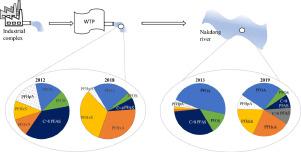Water Research ( IF 11.4 ) Pub Date : 2021-01-10 , DOI: 10.1016/j.watres.2021.116830 Ki Yong Kim , Mlamuli Ndabambi , Sol Choi , Jeong-Eun Oh

|
Concentrations of 28 novel and legacy perfluoroalkyl and polyfluoroalkyl substances (PFASs) in wastewater from 77 industrial plants in the largest industrial complex in Korea were determined. The industrial plants were of eight types (advanced electronic, battery, chemical, general electronic, glass and ceramic, metal, polymer, and textile). PFAS concentrations in river water receiving the wastewater were determined to assess the impact of wastewater from the industrial complex. Only 19 and nine target PFASs were detected in untreated industrial wastewater and river water, respectively. Novel PFASs such as F53B (6:2 chlorinated polyfluoroalkyl ether sulfonate) were not detected. The mean PFASs concentration in industrial wastewater treatment plant effluent was 5.18 µg/L. The mean total PFASs concentration was highest in advanced electronic plant effluent, second highest in general electronic plant effluent, and lowest in battery and chemical plant effluents. Perfluorohexane sulfonate was the dominant homolog, being detected in effluent from plants of all classes and contributing 96% of total discharged PFASs by mass. Perfluorooctane sulfonate (included in the Stockholm Convention) use has decreased markedly since previous studies. Perfluorooctane sulfonate has largely been replaced by PFASs with fewer than seven carbon atoms. A similar change was found for river water receiving industrial wastewater.
中文翻译:

工业废水和接收河水中的遗留物和新型全氟烷基和多氟烷基物质:受管制化合物和替代品相对丰度的时间变化
测定了韩国最大的工业园区中77家工厂的废水中28种新颖和遗留的全氟烷基和多氟烷基物质(PFAS)的浓度。工业工厂有八种类型(高级电子,电池,化学,通用电子,玻璃和陶瓷,金属,聚合物和纺织品)。确定接受废水的河水中的PFAS浓度,以评估工业园区废水的影响。在未经处理的工业废水和河水中分别检测到19种和9种目标PFAS。未检测到新型PFAS,例如F53B(6:2氯化多氟烷基醚磺酸盐)。工业废水处理厂废水中的PFAS平均浓度为5.18 µg / L。PFAS的平均总浓度在高级电子工厂废水中最高,在通用电子工厂废水中第二高,而在电池和化工厂废水中最低。全氟己烷磺酸盐是主要的同系物,在所有类别的工厂废水中均被检测到,占总排放PFAS的96%(质量)。自从先前的研究以来,全氟辛烷磺酸盐(包括在《斯德哥尔摩公约》中)的使用已显着减少。全氟辛烷磺酸已被少于七个碳原子的PFAS所取代。对于接受工业废水的河水也发现了类似的变化。在所有类别的工厂的废水中均被检测到,占总排放PFAS的96%(按质量计)。自从先前的研究以来,全氟辛烷磺酸盐(包括在《斯德哥尔摩公约》中)的使用已显着减少。全氟辛烷磺酸已被少于七个碳原子的PFAS所取代。对于接受工业废水的河水也发现了类似的变化。在所有类别的工厂废水中均被检测到,占总排放PFAS的96%(质量)。自从先前的研究以来,全氟辛烷磺酸盐(包括在《斯德哥尔摩公约》中)的使用已显着减少。全氟辛烷磺酸已被少于七个碳原子的PFAS所取代。对于接受工业废水的河水也发现了类似的变化。











































 京公网安备 11010802027423号
京公网安备 11010802027423号